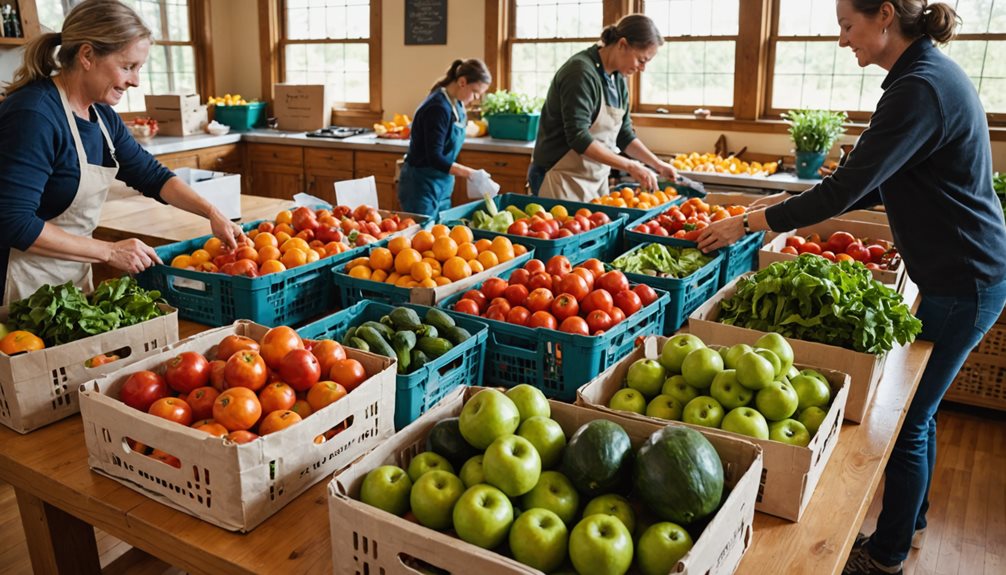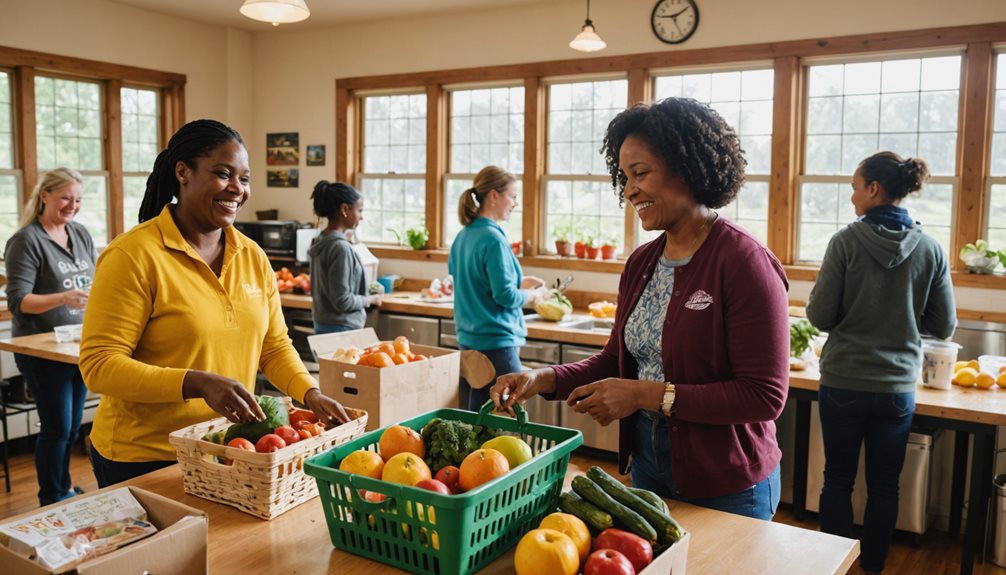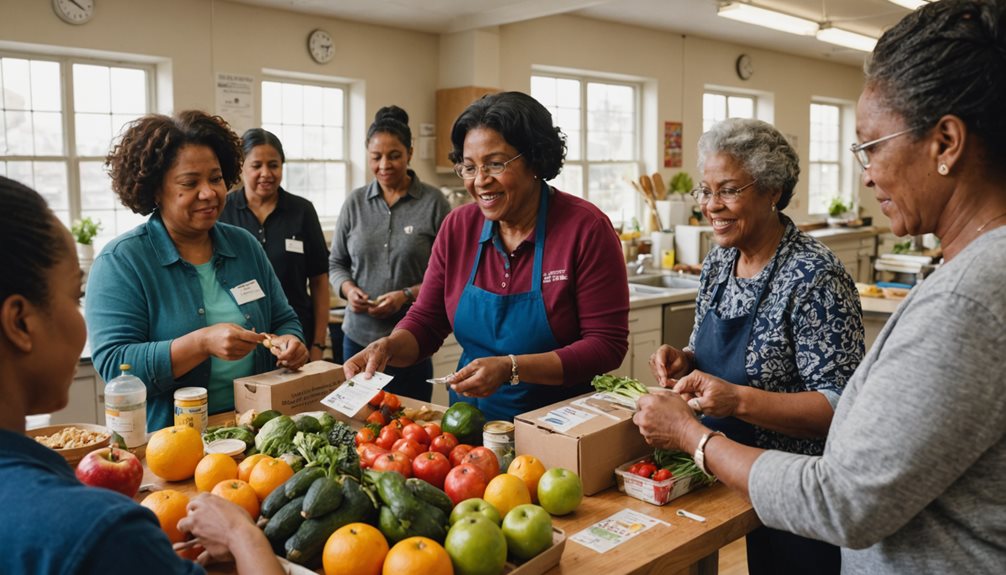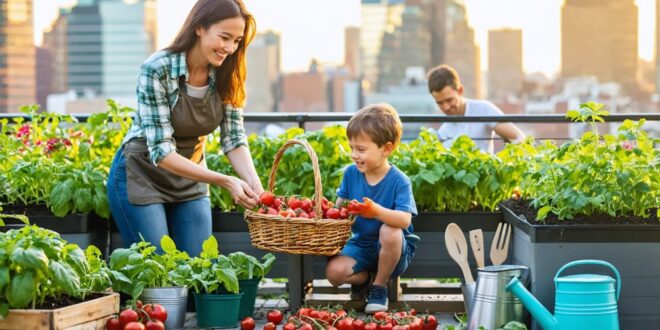You play a crucial role in shaping your community’s nutrition. By donating wholesome foods, volunteering locally, or sharing knowledge about healthy choices, you can make a visible difference. Whether it’s starting a food drive or helping kids learn about better eating habits, your efforts truly matter. Wondering which strategies create the biggest impact—or how to get started? There are accessible ways you can take action right away.
Key Takeaways
- Donate healthy, nutrient-rich foods to local food banks to improve food security and diet quality for vulnerable populations.
- Volunteer or support community gardens to increase local access to fresh fruits and vegetables.
- Organize nutrition awareness campaigns to educate community members about healthy eating and food preparation.
- Lead or participate in food drives that prioritize balanced, nutritious food items for those in need.
- Collaborate with schools to promote nutrition education and healthier food environments for students and families.
Donating Healthy Foods to Local Food Banks

Donating healthy foods to local food banks is an effective method for addressing food insecurity in many communities. Contributions of nutrient-rich foods, such as whole grains, legumes, and canned vegetables, help supply essential nutrients that might otherwise be lacking in the diets of food-insecure populations.
The inclusion of fresh produce in donations further supports access to fruits and vegetables, which are important for maintaining overall health. Organizing food drives can encourage community participation and enhance understanding of nutritional needs.
Additionally, volunteering with food banks allows individuals to contribute to the distribution process and gain insight into food access challenges within their local area.
Supporting and Volunteering at Community Gardens
In addition to donating food to local food banks, individuals can contribute to addressing food insecurity by supporting and volunteering at community gardens.
These gardens play a practical role in increasing access to fresh produce, particularly in areas where such options are limited. Volunteering at a community garden can help facilitate collaboration among residents and foster community engagement.
Research indicates that community gardens are associated with increased fruit and vegetable consumption, which can contribute to improved dietary quality.
Many community gardens also offer educational initiatives focused on gardening techniques, nutrition, and food preparation, thereby providing participants with practical skills.
Organizing Nutrition Awareness Campaigns
Organizing nutrition awareness campaigns is a practical approach to promoting healthier eating habits within a community.
These campaigns often include workshops, cooking demonstrations, and informational sessions designed to educate individuals about the role of nutrition in maintaining overall health.
Collaboration with local health organizations or educational institutions can extend the reach of these initiatives and facilitate engagement among diverse groups.
Utilizing social media platforms and participating in local events are effective methods for disseminating information and encouraging involvement.
Collecting feedback and assessing the outcomes of each campaign is important for measuring effectiveness and informing the planning of future activities.
This structured approach can contribute to improved nutrition awareness at the community level.
Leading Food Drives to Promote Balanced Diets

Organizing food drives with an emphasis on balanced diets can contribute to improved community nutrition by increasing the availability of healthier food options for individuals experiencing food insecurity.
Prioritizing donations such as canned vegetables, whole grains, and nutrient-dense snacks supports efforts to address dietary gaps and encourage healthier eating patterns among recipients.
Collaborating with local food banks can help determine which types of food items are most needed to promote balanced diets, ensuring that food drives respond effectively to existing nutritional deficits within the community.
Additionally, promoting nutrition-focused themes and clearly communicating donation guidelines may encourage informed participation and raise awareness about the importance of nutritional quality in food assistance programs.
Collaborating With Schools to Encourage Healthy Eating
Schools have an important influence on students’ dietary behaviors in addition to their academic responsibilities. Collaborative efforts with schools can enhance nutrition education by implementing evidence-based programs that teach children about balanced diets and healthy food choices.
Involving educators and parents in initiatives such as cooking demonstrations and taste tests can familiarize students with a variety of nutritious foods. Supporting school policies that limit access to sugary snacks and beverages, while prioritizing fresh produce, can create a healthier food environment.
Additionally, offering workshops for parents may reinforce consistent nutrition messages between school and home. These measures are supported by research indicating that coordinated school-community approaches are effective in promoting healthy eating patterns among students, which can contribute to improved health outcomes over time.
Promoting Farmers’ Markets and Local Produce Initiatives
Fresh fruits and vegetables generally contain higher nutritional value and better flavor compared to processed alternatives. Promoting farmers’ markets and local produce initiatives can contribute to improved community nutrition by increasing access to fresh produce and diverse healthy food options.
Supporting the establishment of additional farmers’ markets or participation in community-supported agriculture (CSA) programs are ways to facilitate this access. Volunteering at these events can help maintain their operation and reach.
Organizing or attending farm-to-table events also encourages the use of locally sourced ingredients. Providing information about the benefits of consuming seasonal fruits and vegetables further informs the public.
These actions may support improved nutrition, promote sustainable agricultural practices, and strengthen community connections.
Educating Community Members on Reading Nutrition Labels

Understanding how to read nutrition labels is an important skill for making informed food choices. Nutrition labels provide essential information such as calorie content, serving size, amounts of sugars, fats, and sodium.
This data can help individuals manage their intake and reduce the risk of diet-related conditions, including obesity, diabetes, and hypertension. Educational initiatives, such as workshops or informational materials, can assist community members in interpreting nutrition labels more effectively.
Increased awareness and competence in label reading may contribute to healthier purchasing decisions and can influence local demand for nutritious foods. Over time, this can support improved public health outcomes as individuals apply this knowledge to their dietary habits.
Encouraging Family and Peer Involvement in Healthy Eating Choices
Involving family members and peers in making healthy eating choices can help establish and reinforce nutritious habits. Including all household members in meal planning and recipe selection promotes shared responsibility and increases nutrition knowledge.
Participating in grocery shopping as a group allows children and adults to practice interpreting nutrition labels and making informed decisions. Organizing family cooking sessions can further develop practical food preparation skills and familiarity with healthier recipes.
Sharing nutritious recipes with friends or community groups may contribute to wider adoption of healthy eating practices. Additionally, joining or supporting a community garden can facilitate access to fresh produce and encourage collaborative learning about nutrition and food systems.
 Mindful Vitals This is a blog about health.
Mindful Vitals This is a blog about health.

